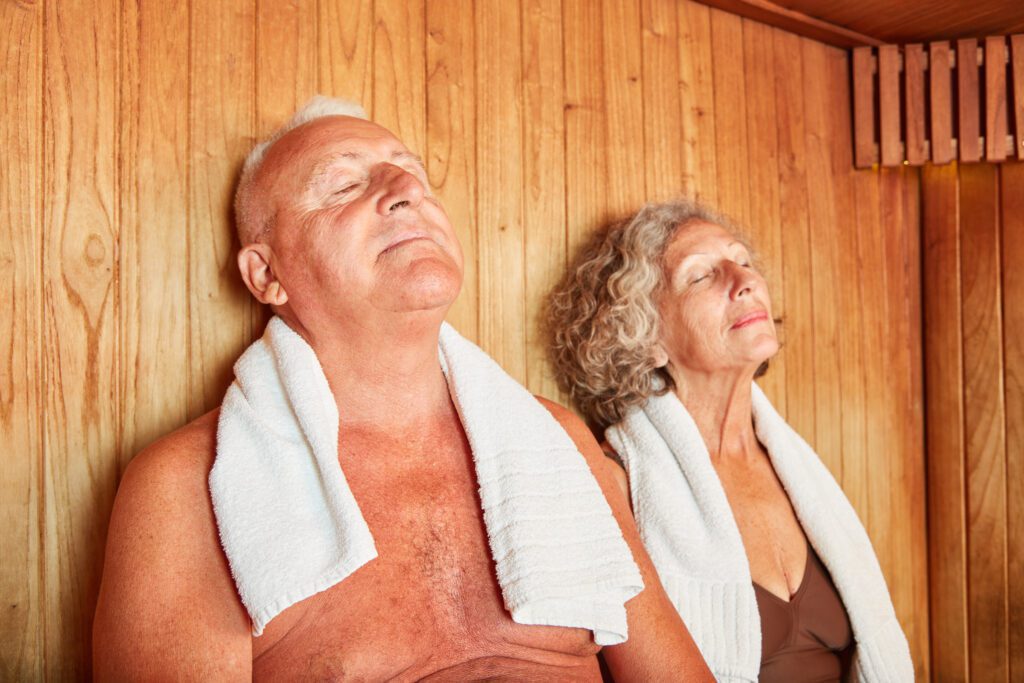Home saunas have gained popularity to enhance overall wellness and improve sleep quality. Steam saunas, which generate moist heat, create an environment that encourages relaxation and can lead to numerous health benefits. Steam sauna sessions mimic mild exercise’s effects by inducing sweating and increasing heart rate, promoting cardiovascular health.
Incorporating steam sauna sessions into one’s routine may also directly impact sleep patterns. The warmth and relaxation experienced during a sauna session can help to ease muscle tension and calm the mind, setting the stage for a more restful sleep. As the body cools down post-sauna, it may signal the brain to prepare for sleep, aiding in the transition to deeper sleep stages.
Key Takeaways
- Home steam saunas may enhance cardiovascular health and promote relaxation.
- Regular sauna use is associated with improved sleep quality.
- Cooling down after sauna sessions can help signal the body to prepare for restful sleep.
Table of Contents
Overview of Home Saunas

Types of Saunas
There are several types of saunas, each offering a different experience:
- Steam Saunas: Also known as Turkish baths, they generate moist heat with high humidity, generally 100%, by boiling water to create steam.
- Dry Saunas: These use dry heat with lower humidity levels, usually generated by hot stones.
- Infrared Saunas: Instead of heating the air, they use infrared lamps to warm the body directly.
Components of a Home Steam Sauna
A home steam sauna includes various components:
- Steam Generator: The heart of the sauna, boiling water to produce steam.
- Control Panel: Allows users to adjust temperature and humidity levels.
- Seating Area: Typically made of water-resistant materials like cedar or eucalyptus wood.
- Insulated Walls and Door: Usually with glass sections to retain steam and allow light.
- Ventilation System: Ensures proper air circulation and steam distribution.
History and Cultural Significance
- Finland: Saunas have been integral, often seen in nearly every home for their health and social benefits.
- Turkish Baths: A variation of steam saunas, pivotal in Middle-Eastern cleansing rituals, emphasizing relaxation and detoxification.
Understanding Sauna Therapy
Sauna therapy is the practice of using saunas for health benefits like:
- Relaxation: The heat helps muscles relax and reduces stress.
- Detoxification: Induces sweating, which may help eliminate toxins from the body.
- Sleep Improvement: The post-sauna cool-down may promote deeper sleep.
- Sauna Benefits: Regular sauna use is linked to cardiovascular and respiratory enhancements.
Health Benefits of Sauna Use
Regular sauna use has been linked to numerous health benefits, from improved cardiovascular health to enhanced sleep, which can contribute significantly to overall wellness. Saunas are known for their ability to promote relaxation and potentially support the immune system.
Cardiovascular Health
Sauna use has been associated with a lower risk of heart disease. It can help improve circulation and even lower blood pressure in regular users. Studies suggest that high temperatures can cause blood vessels to expand, leading to improved cardiovascular health.
Enhanced Sleep Patterns
Regular sauna sessions may contribute to improved sleep. The heat can help to relax the muscles and release tension, promoting a sense of calm that can lead to deeper, more restful sleep.
Weight Management
While saunas are not a weight loss solution, they can support weight management through increased metabolism and calorie burning. Heat exposure requires the body to work harder to cool itself, which can help burn calories.
Muscle and Pain Relief
The heat from a sauna can relieve muscle soreness and reduce pain due to chronic conditions like arthritis. It promotes relaxation, and the increased blood flow aids in the faster removal of metabolic waste products, leading to inflammation reduction.
Recovery and Athletic Performance
For athletes, sauna usage may facilitate recovery after intense physical activity. Enhanced blood flow helps repair torn muscles, while heat stress can improve athletic performance by increasing endurance and reducing fatigue.
Specific Health Conditions and Sauna Use

Saunas are increasingly recognized for their potential therapeutic benefits in managing various health conditions, including respiratory and dermatological issues and mental health challenges. Home steam saunas, in particular, provide a controlled environment where individuals can leverage heat for health improvements.
Respiratory Health and Lung Function
Individuals with respiratory conditions may find symptomatic relief through regular sauna use. The heat can help improve lung function and reduce congestion, particularly for those with asthma or chronic bronchitis. According to Verrywell Health, sauna sessions may benefit lung function and breathing easier, making them an adjunct to traditional respiratory therapies.
Mental Health and Relaxation
For mental health, saunas can have a significant stress-relief and relaxation effect. They induce a state of relaxation, which can lower stress levels. Conditions such as fibromyalgia and dementia may see an improvement in symptoms, as heat therapy reduces pain and enhances feelings of well-being. Studies referenced by Forbes Health suggest that sauna sessions help ease the psychological stress burden, offering a moment of tranquility and reprieve.
Dermatological Effects
In terms of skin health, sauna usage encourages sweating, which is a natural mechanism for detoxification. Sweat helps remove impurities from the skin, leading to clearer, more toned skin. The dry heat of a sauna can also increase skin temperature, enhancing blood circulation, which is essential for a healthy skin complexion. Harvard Health Publishing outlines that sauna use elevates skin temperature, subsequently increasing heart rate and blood flow, mirroring the effects of moderate exercise, which can benefit the skin.
Scientific Insights on Sauna Benefits
Recent scientific studies have cast light on the remarkable ways regular sauna use can benefit the body’s systems, particularly in improving sleep and enhancing overall wellness. The following subsections delve into the specific effects of sauna use on circulation, detoxification, and the immune system.
Circulation and Blood Flow
Regular sauna use has been shown to improve circulation significantly. As the body is exposed to the heat, blood vessels dilate, increasing blood flow. This enhanced circulation can help nourish tissues and improve overall cardiovascular function.
Detoxification Process
Sweating induced by sauna use is a critical factor in the body’s detoxification process. As the sweat glands become active, they help flush out toxins, including heavy metals. This process supports the liver, which filters and detoxifies the body’s bloodstream.
Influence on Immune System
Heat shock proteins produced during sauna sessions can bolster the immune system by helping the body combat inflammation and repair damaged proteins. Furthermore, saunas can induce the release of endorphins, which not only provide a sense of relaxation and well-being but also might possess modulatory effects on the immune system.
In summary, these physical responses to the heat of a sauna—improved circulation, enhanced detoxification processes, and a strengthened immune system—underscore the health benefits of regular sauna use.
User’s Guide to Home Sauna Sessions

Incorporating home sauna sessions into a daily routine can provide a restorative and therapeutic experience. Maintaining the correct temperature and duration for safety and maximum benefits, staying hydrated, and managing a proper cool-down process are crucial.
Ideal Temperature and Duration
The ideal temperature for a home sauna—whether a wet sauna with higher humidity or a traditional sauna with dry heat—is typically between 150°F and 175°F. At these high temperatures, akin to moderate exercise, the body can reap the benefits of heat therapy. Sessions should last between 15 and 20 minutes to avoid extreme heat exposure, with the option to pour water over sauna stones to adjust the humidity levels to comfort.
Hydration and Precautions
Staying hydrated is essential; one should drink water before, during, and certainly after a sauna session to prevent dehydration. Beginning with cool water, gradually increase intake as hydration becomes more crucial. Alcohol consumption before sauna use is a risk factor and should be avoided to ensure a safe sauna experience. Recognize personal limits and consult a healthcare professional if one has medical conditions that may be affected by heat stress.
Post-Sauna Cool Down
A gradual cool-down is vital to regulate the body’s temperature after leaving the sauna. Resting for at least 10 minutes is recommended, allowing the body temperature to return to normal. A cool shower can aid the cooling process and enhance the therapeutic experience of sauna use. The cool-down is the phase where one can truly relax and feel the therapeutic effects of the sauna session.
Considerations and Safety Tips

Before exploring the health benefits of home steam saunas, it’s imperative to understand the importance of safety and proper maintenance. Adherence to guidelines not only ensures a safer experience but also extends the lifespan of your sauna.
Medical Advice and Consultation
Those considering the regular use of a home steam sauna should consult with a physician beforehand, especially if they have pre-existing health or medical conditions. Sauna use can impact blood pressure, and those on medications or experiencing dizziness should exercise caution. Physician consultation is crucial to avoid adverse effects, particularly for those with cardiovascular conditions or who are pregnant.
Operating Safely and Maintenance
To operate a sauna safely, users should be mindful of the dry heat and humidity levels central to the experience. Saunas should maintain appropriate humidity levels to offer moist heat without creating excessive steam that might cause discomfort or respiratory issues. Proper maintenance is necessary to ensure the environment is clean and safe. After use, a sauna should be aired out to prevent mold and scale buildup, parts should be regularly checked for wear, and the heating element should be inspected to ensure efficient and safe operation.
Personal Experience and Testimonials
Individuals regularly using home steam saunas often report tangible benefits regarding their sleep and overall wellness. Testimonials vary based on personal experience, but many reflect common themes of improved quality of life and health.
Wellness and Quality of Life Improvements
Those who incorporate sauna sessions into their routine describe a significant enhancement in their overall wellness. It’s not uncommon for users to mention feelings of relaxation immediately following a sauna, which they attribute to the heat’s soothing properties. Personal accounts typically include a better quality of sleep, attributing to the heat’s capacity to relax muscle tension and promote a state conducive to rest. Anecdotal evidence gathered from individuals also points to a therapeutic experience resembling a spa day without the associated costs and the convenience of accessibility, contributing to a sustained sense of well-being.
Individual Differences and Preferences
People’s preferences for their sauna experiences are as varied as their accounts of the benefits they receive. Some prefer the dry heat of an infrared sauna, while others favor the humid embrace of a steam sauna. Tolerance to heat also plays a role, with testimonials emphasizing the importance of listening to one’s body and adjusting the temperature accordingly. Heat preference can affect the frequency and duration of sessions, thus influencing the personalized therapeutic effects experienced by each individual. Sauna users often note that the ability to customize the sauna experience to personal preference is a significant factor in the enjoyment and wellness benefits of home saunas.
Frequently Asked Questions
In this section, readers will learn about the varied health benefits of using home steam saunas, their impact on sleep, potential risks, and guidelines for optimal use to enhance overall wellness.
What are the specific health benefits of using a home steam sauna?
Home steam saunas are recognized for their ability to promote relaxation and reduce stress. Regular sessions also contribute to improved circulation and joint support and can be part of a holistic approach to health.
How can regular use of a steam sauna influence sleep quality?
Exposure to the heat of a steam sauna can lead to a state of relaxation, which may improve sleep quality. It simulates a natural drop in body temperature post-heat, signaling to the body that it’s time to sleep.
Are there any risks associated with using steam saunas frequently?
Although steam sauna use is generally safe for healthy adults, individuals with certain medical conditions or those who are pregnant should exercise caution. The high temperatures can pose risks, such as dehydration and heat exhaustion.
How does steam sauna usage affect overall wellness?
Regular sessions in a steam sauna may contribute to improved circulation and joint support, complementing an effective wellness routine. The heat can also stimulate endorphin release, enhancing mood.
What is the recommended duration for a steam sauna session to maximize health benefits?
A typical steam sauna session should last around 15-20 minutes. Users should listen to their bodies and exit if they feel uncomfortable or overheated to avoid adverse effects.
Can using a steam sauna post-workout aid in muscle recovery?
Steam sauna sessions post-workout can help with muscle recovery by increasing muscle blood flow, potentially reducing soreness and speeding up the recovery process.



